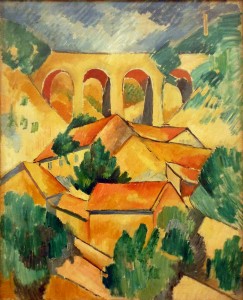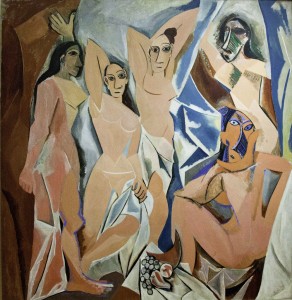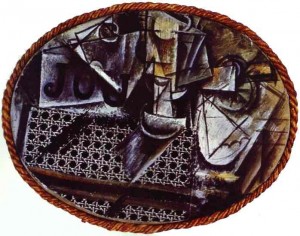Cubism
Cubism was created by Pablo Picasso and Georges Braque in Paris between 1907 and 1914 and was known as one of the most influential visual art styles of the twentieth century. (Rewald 2004) The term Cubism came from the art critic Louis Vauxcelles after seeing landscapes Brauqe had painted in 1908 at L’Estaque in emulation of Cézanne. (Rewald 2004). Cubist painters went against the concept that art should simply copy nature and did not want to adapt to the traditional techniques of painting.

Viaduct at L’Estaque
by Georges Braque , used under ![]()
In Cubist work up to 1910, the subject of a picture was typically unclear. The artists wanted to emphasize the two-dimensionality of the artwork and did so by reducing and fracturing objects in the paintings into geometric forms. They then realigned the geometric shapes within a shallow space. The figures and objects were dissected into a number of small features and then reassembled to evoke the same figures or objects from the original image. During a time of Cubism from 1910-12 referred to as Analytical Cubism, Picasso and Braque abstracted their work to even further lengths. It became just a series of overlapping planes and features mostly in browns, blacks, or grays. During this period they also combined representational motifs into their work combined with letters. Their favorite motifs included still life’s with musical instruments, bottles, pitchers, glasses, newspapers, playing cards, and the human figure. (Reward 2004) An example of Analytical Cubism can be seen below.

Les Demoiselles d’Avignon
by Pablo Picasso, used under 
Another phase of Cubism that developed after 1912 is known as Synthetic Cubism. Rather than the breaking down of images into geometric objects, this phase focused on the combination of forms in the picture. Color became extremely important in the shapes along with the contrast of smooth and rough surfaces. A collage technique was developed by pasting non-painted objects, such as newspapers or tobacco wrappers, on the canvas in combination with painted areas. This was utilized to emphasize difference in texture and pose the question of reality.

Still-Life with Chair Caning
by Pablo Picasso , used under 
An influential artist in the cubist movement is Paul Cézanne (1839-1906). While he is generally known as a post-impressionist, his methods of building form with color, and using an analytical approach largely influenced cubism. (Voorhies 2000)

Bibemus Quarry
by Paul Cézanne, used under 
Bibliography
Jmussuto. (Photographer). (2010, June 7). Pablo Picasso, Still-Life with Chair Caning [Web Photo]. Retrieved from https://flic.kr/p/88vEwd
Kent Baldner. (Photographer). (2011, June 4). Pablo Picasso, Les Demoiselles d’Avignon [Web Photo]. Retrieved from https://flic.kr/p/anh9AM
Moffat, C. A. (n.d.). The Art Hisotry Archives- Art Movements . Retrieved April 7-14, 2014, from Cubism: http://www.arthistoryarchive.com/arthistory/cubism/
Paul Cézanne (1898). Bibemus Quarry [Oil painting], Retrieved April 15, 2014, from: https://flic.kr/p/2FMJ7q
Rewald, S. (2004, October ). Cubism . (T. M. Art, Producer) Retrieved April 7-14, 2014, from Heilbrunn Timeline of Art History : http://www.metmuseum.org/toah/hd/cube/hd_cube.htm
Steven Zucker. (Photographer). (2011, March 23). Braque, Viaduct at L’Estaque( 1908) [Web Photo]. Retrieved from https://flic.kr/p/a6LQNk
Voorhies, J. (2004, October ). Paul Cézanne (1839–1906). (T. M. Art, Producer) Retrieved April 7-14, 2014, from Heilbrunn Timeline of Art History : http://www.metmuseum.org/toah/hd/pcez/hd_pcez.htm
